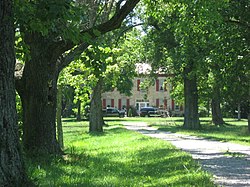Oak Hill | |
 Distant view of the house | |
| Location | Dun Rd., Chillicothe, Ohio |
|---|---|
| Coordinates | 39°19′35″N83°1′28″W / 39.32639°N 83.02444°W |
| Area | Less than 1 acre (0.40 ha) |
| Built | 1838 |
| Architect | G.W. Dun |
| Architectural style | Federal, vernacular Adam style |
| NRHP reference No. | 73001527 [1] |
| Added to NRHP | April 3, 1973 |
Oak Hill is a historic former farmhouse in the southern part of the U.S. state of Ohio. Located along Dun Road in Ross County, [1] it is one of the finest examples of sandstone farmhouses in the vicinity of the city of Chillicothe. [2]
The house was built by George William Dun, a native of Scotland who settled near Chillicothe in 1838. Almost immediately upon taking up residence at the site, he began the construction of his house, which was completed in 1840. A large two-story building constructed in the Federal style of architecture, it represents an American version of the British Adam style. [2]
In 1973, the house was listed on the National Register of Historic Places because of its well-preserved historic architecture. [1] It received this recognition for multiple reasons: the massive hardwood trees on the grounds evoke a sense of antiquity; the exterior is better preserved than that of almost any other period sandstone house; and the interior retains much of its original condition, including much of the furniture once owned by George Dun's ancestors. [2]


